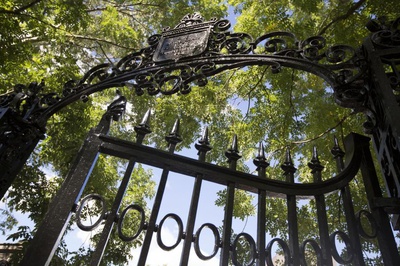
News
Nearly 200 Harvard Affiliates Rally on Widener Steps To Protest Arrest of Columbia Student

News
CPS Will Increase Staffing At Schools Receiving Kennedy-Longfellow Students

News
‘Feels Like Christmas’: Freshmen Revel in Annual Housing Day Festivities

News
Susan Wolf Delivers 2025 Mala Soloman Kamm Lecture in Ethics

News
Harvard Law School Students Pass Referendum Urging University To Divest From Israel
Science Center To Undergo Renovation
$22 million, 20-month building expansion to begin in summer of 2002
Construction of a $22 million, 32,000 square foot addition to the Science Center will begin this summer after three years of planning.
The bulk of the addition—three new stories above the current administrative wing along Oxford Street—will consist of increased space for the history of science department. The first floor will be a new museum to house their scientific instrument collection, with the second and third floors containing new seminar rooms and office space.
The project is expected to last 20 months, reaching completion in fall 2003.
“The main thrust of this project is not for classroom space in the conventional sense, but the history of science department will be gaining an informal seminar room for demonstrations,” said Jeffrey J. Cushman ’69, capital projects manager for the Faculty of Arts and Sciences (FAS) department of physical resources.
The project will also add a two stories to the west end of the building, and 1,800 square feet of additional space on the sixth floor roof behind the central staircase.
A need for adequate space to house the scientific instrument collection—most of which is being temporarily stored in the basement of the Science Center—along with Harvard University Arts and Sciences Computer Services’ (HASCS) need to expand were the two main factors that originally prompted the FAS physical resources department to investigate the possibility of an addition.
“We have grown and just squeezed into corners,” said Franklin M. Steen, director of FAS Computer Services.
HASCS will benefit from the expansion in several ways. The user area in the basement will be reconfigured. The department will also gain two new, smaller computer classrooms on the second floor in replacement for the one currently located on the first floor.
The technology showcase, a room where high-end equipment is kept for student use, will also be increasing in size, from 300 to 800 square feet.
“We had hoped to gain some more computers, since the current ones are under such great demand, but it looks like the number of available computers is going to stay about the same,” Steen said.
The statistics department will occupy the 1,800 square foot addition on the sixth floor roof. The department will gain new office space for Faculty members and teaching fellows, a better designed classroom and more office and computing space for post-graduate fellows.
“We will be gaining more space, but the greater benefit is better space utilization, which will allow for better Faculty and student interaction,” said Betsy B. Cogswell, department administrator.
The mathematics department will also be gaining office space, as will the Derek Bok Center for Teaching and Learning.
“The Science Center is such an important building that we wanted to make the most of the disruption, and as we were examining the existing needs, others surfaced,” said Celia Kent, director of planning.
The project coordinators are confident that Science Center activities will not be disrupted throughout the project and say that the biggest issue will be relocating the computer stations while the downstairs labs are being renovated.
“The project has been specifically designed in phases in order to minimize the effects of the construction,” Kent said.
The Science Center was originally designed by José Luis Cert, a former dean of the Graduate School of Design, and was completed in 1973. The building is shaped like a Polaroid camera due to the fact that Polaroid founder Edwin Land, Class of 1930, donated most of the money for the building.
The new renovation, designed by Andrea Leers of the Leers Weinzepfel Association, will be composed mostly of glass and will incorporate the design of the existing building, while remaining visually distinct.
“The Science Center is a landmark building, and the addition will be compatible with the essence of the building, while not trying to fake that something has changed,” Cushman said.
“This project is one of several that we must undertake to give breathing room to departments, and to allow us to
increase the size of the faculty,” Dean of the Faculty Jeremy R. Knowles wrote in an e-mail.
Want to keep up with breaking news? Subscribe to our email newsletter.
Most Read
From Our Advertisers

Over 300+ courses at prestigious colleges and universities in the US and UK are at your disposal.

With innovative financial tools combined with financial education, Collegiate empowers students to take control of their finances and build confidence in their money management skills.

Serve as a proctor for Harvard Summer School (HSS) students, either in the Secondary School Program (SSP), General Program (GP), or Pre-College Program.

With an increasingly competitive Law School admissions process, it's important to understand what makes an applicant stand out.

Welcome to your one-stop gifting destination for men and women—it's like your neighborhood holiday shop, but way cooler.

Admit Expert is a premium MBA admissions consulting company, helping candidates secure admission to top B-schools across the globe with significant scholarships.
